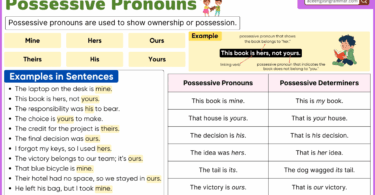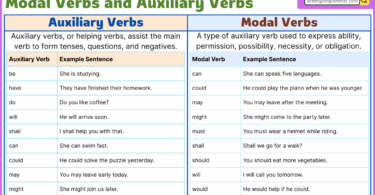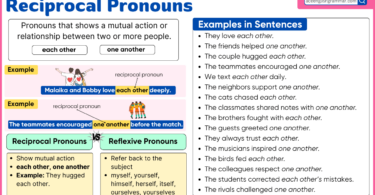English learners often get confused between possessive nouns and possessive pronouns. Many struggle to decide where to place the apostrophe or how to show ownership clearly. This blog post will help you understand what possessive nouns are, how to use them correctly, and give you a clear possessive nouns list with examples to avoid common grammar mistakes.
Table of Contents
Meaning of Possessive Nouns
A possessive noun shows ownership or a relationship between things. It tells us that something belongs to someone.
- Fatima’s book – the book belongs to Fatima.
- The boys’ shoes – the shoes belong to the boys.
Possessive nouns are usually formed by adding an apostrophe + s (’s) or just an apostrophe (’) depending on whether the noun is singular or plural.
Possessive Nouns List
- Ahmad’s bag
- Amina’s dress
- The teacher’s notebook
- My sister’s laptop
- The cat’s tail
- Bilal’s room
- Zainab’s phone
- The boys’ team
- My parents’ advice
- The students’ homework
- Hamza’s idea
- Mariam’s scarf
- The doctor’s clinic
- The girls’ books
- The children’s toys
- Yusuf’s camera
- Sara’s diary
- The lion’s roar
- The guests’ luggage
- The driver’s seat
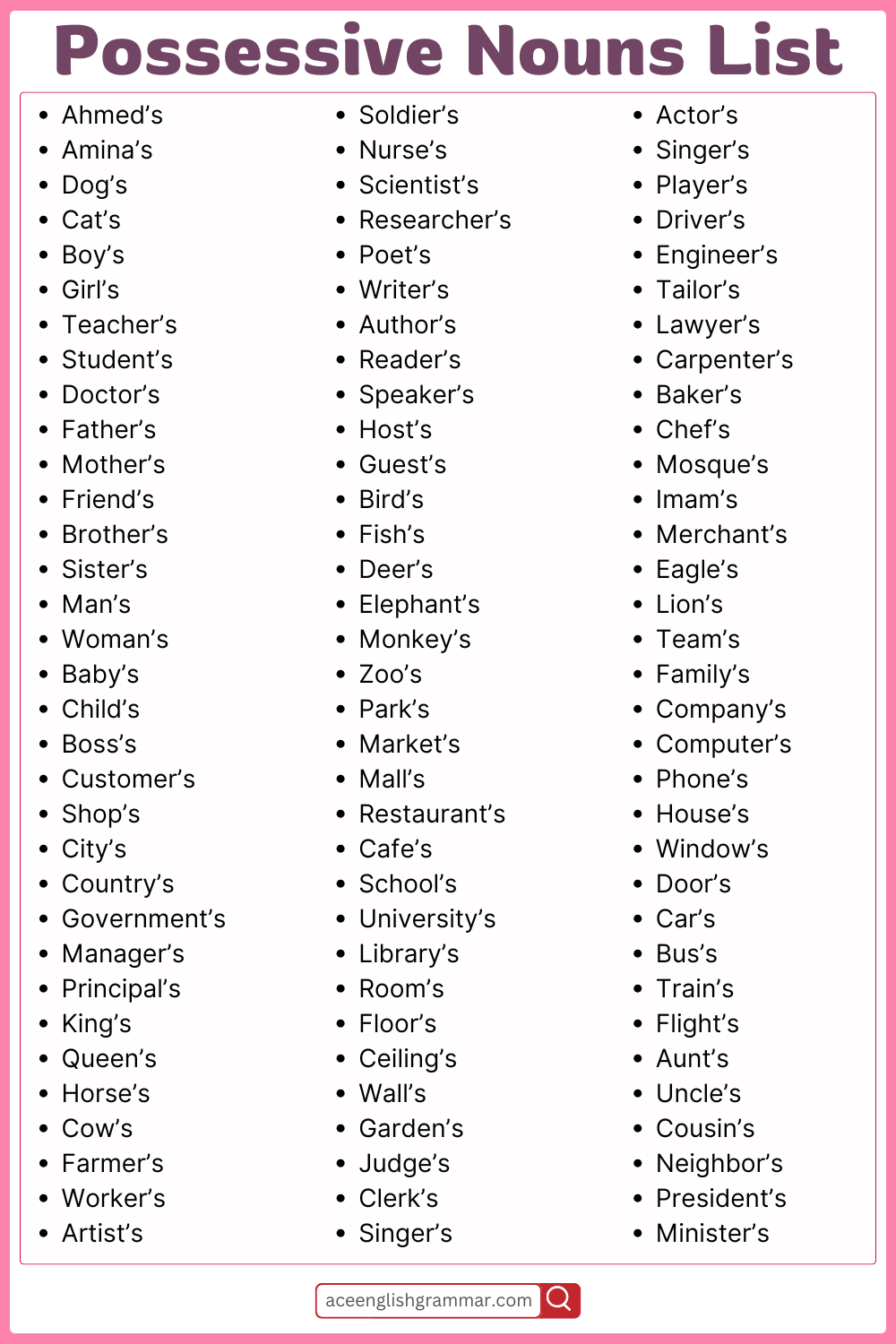
List of Singular Possessive Nouns
Singular possessive nouns show ownership by one person or thing. Formed by adding ’s.
- the girl’s book
- Ahmed’s pen
- the teacher’s desk
- the cat’s tail
- the baby’s toy
- Aisha’s scarf
- the dog’s bone
- the student’s homework
- the sun’s rays
- the car’s engine
List of Plural Possessive Nouns
Plural possessive nouns show ownership by more than one person or thing. Formed by adding s’ or ’s (if the plural form is irregular).
- the girls’ room
- the students’ project
- the cats’ food
- the players’ coach
- the teachers’ lounge
- the cars’ tires
- the boys’ uniforms
- the books’ covers
- the houses’ roofs
- the dogs’ leashes
List of Irregular Possessive Nouns
Irregular possessive nouns have non-standard plural forms and still show ownership by adding ’s.
- children’s toys
- men’s shoes
- women’s clothes
- oxen’s yoke
- mice’s tails
- geese’s wings
- people’s opinions
- feet’s arches
- teeth’s enamel
- sheep’s wool
50 Common Possessive Nouns
| Possessive Noun | Base Noun | Example Sentence |
|---|---|---|
| Ahmed’s | Ahmed | Ahmed’s car is new. |
| Amina’s | Amina | Amina’s phone is ringing. |
| Dog’s | Dog | The dog’s tail is wagging. |
| Cat’s | Cat | The cat’s eyes are glowing. |
| Boy’s | Boy | The boy’s bike is broken. |
| Girl’s | Girl | The girl’s doll is missing. |
| Father’s | Father | My father’s shoes are brown. |
| Friend’s | Friend | My friend’s house is far. |
| Brother’s | Brother | My brother’s room is clean. |
| Sister’s | Sister | Her sister’s voice is sweet. |
| Man’s | Man | The man’s hat is blue. |
| Woman’s | Woman | The woman’s purse is black. |
| Baby’s | Baby | The baby’s toy is soft. |
| Queen’s | Queen | The queen’s crown sparkled. |
| Horse’s | Horse | The horse’s mane is long. |
| Cow’s | Cow | The cow’s horn is big. |
| Farmer’s | Farmer | The farmer’s field is fertile. |
| Worker’s | Worker | The worker’s uniform is dirty. |
| Player’s | Player | The player’s jersey is red. |
| Driver’s | Driver | The driver’s seat is comfortable. |
| Engineer’s | Engineer | The engineer’s plan is brilliant. |
| Tailor’s | Tailor | The tailor’s shop is busy. |
| Lawyer’s | Lawyer | The lawyer’s advice was clear. |
| Carpenter’s | Carpenter | The carpenter’s tools are sharp. |
| Baker’s | Baker | The baker’s bread smells nice. |
| Chef’s | Chef | The chef’s recipe is secret. |
| Student’s | Student | The student’s book is torn. |
| Mosque’s | Mosque | The mosque’s minaret is tall. |
| Imam’s | Imam | The imam’s voice is soothing. |
| Tailor’s | Tailor | The tailor’s work is neat. |
| Eagle’s | Eagle | The eagle’s wings are wide. |
| Lion’s | Lion | The lion’s roar is loud. |
| Team’s | Team | The team’s spirit is strong. |
| Family’s | Family | The family’s car is old. |
| Company’s | Company | The company’s policy is strict. |
| Phone’s | Phone | The phone’s battery is dead. |
| House’s | House | The house’s roof is leaking. |
| Window’s | Window | The window’s glass broke. |
| Door’s | Door | The door’s handle is loose. |
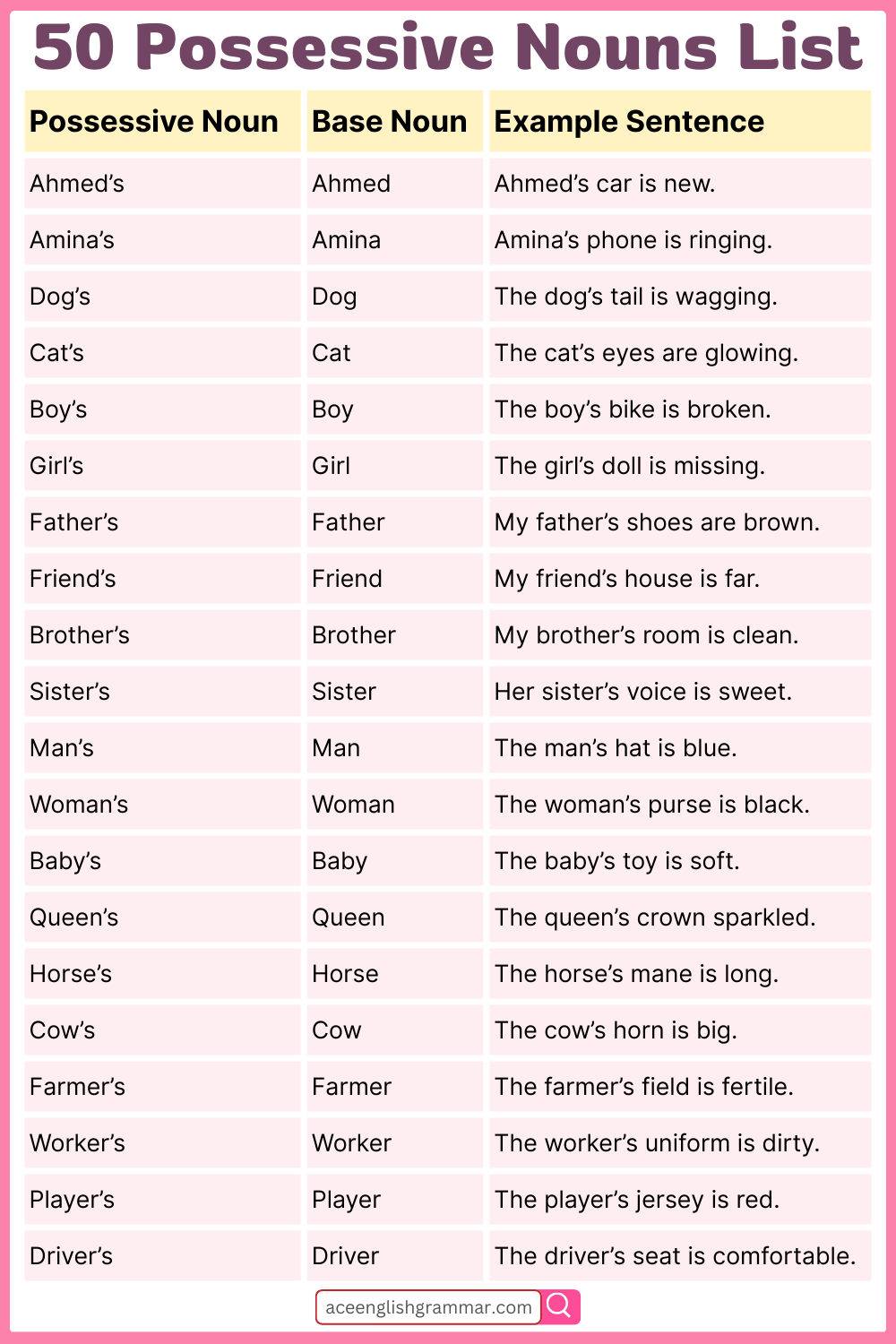
Forming a Possessive Noun
Here are the basic rules to form possessive nouns correctly:
1. For Singular Nouns: Add ’s
- Khadija → Khadija’s scarf
- The cat → The cat’s tail
2. For Plural Nouns Ending in S: Add only ’
- Friends → Friends’ party
- Parents → Parents’ room
3. For Irregular Plural Nouns: Add ’s
- Children → Children’s games
- Men → Men’s clothes
4. For Compound Nouns: Add ’s to the end
- My brother-in-law’s car
Possessive Nouns List in Sentences
Each sentence below uses a possessive noun to show ownership:
- Hassan’s jacket was left on the chair.
- We visited Fatima’s house last night.
- The teacher’s explanation was very clear.
- Hamza’s phone is ringing.
- The doctors’ meeting was delayed.
- I borrowed Yusuf’s pen.
- My uncle’s car is very old.
- The children’s laughter filled the room.
- Sara’s diary is private.
- The girls’ uniforms were blue.
Difference Between Possessive Nouns and Possessive Pronouns
Here’s a comparison table showing the key differences:
| Feature | Possessive Noun | Possessive Pronoun |
|---|---|---|
| Shows ownership | Yes | Yes |
| Formed with apostrophe | Yes (e.g., Ahmad’s, girls’) | No (e.g., his, hers) |
| Follows the noun | Yes | Replaces the noun |
| Examples | This is Amina’s dress. | This dress is hers. |
| That is the teacher’s chair. | That chair is his. |
30 Examples List of Possessive Nouns
- Ali’s shoes are under the table.
- This is Noor’s favorite book.
- I borrowed Huda’s charger.
- The student’s essay was excellent.
- The boys’ room is messy.
- My brother’s car is red.
- That is Imran’s pencil.
- The teacher’s bag is new.
- The babies’ toys are colorful.
- The lion’s roar was loud.
- Yasmin’s phone rang during class.
- Zayd’s handwriting is neat.
- The girls’ shoes are missing.
- Umar’s idea was brilliant.
- Hafsa’s umbrella is broken.
- The driver’s license expired.
- We attended Sara’s birthday.
- That’s Rashid’s watch.
- The men’s jackets were on sale.
- Fatima’s scarf is beautiful.
- Bilal’s dog is very friendly.
- The cat’s whiskers are long.
- The children’s books are on the shelf.
- Mariam’s ring is missing.
- The shop’s door was open.
- My cousin’s flight was delayed.
- Khadija’s henna looked lovely.
- My aunt’s garden is large.
- Usman’s cap flew away.
- The birds’ nest is on the tree.
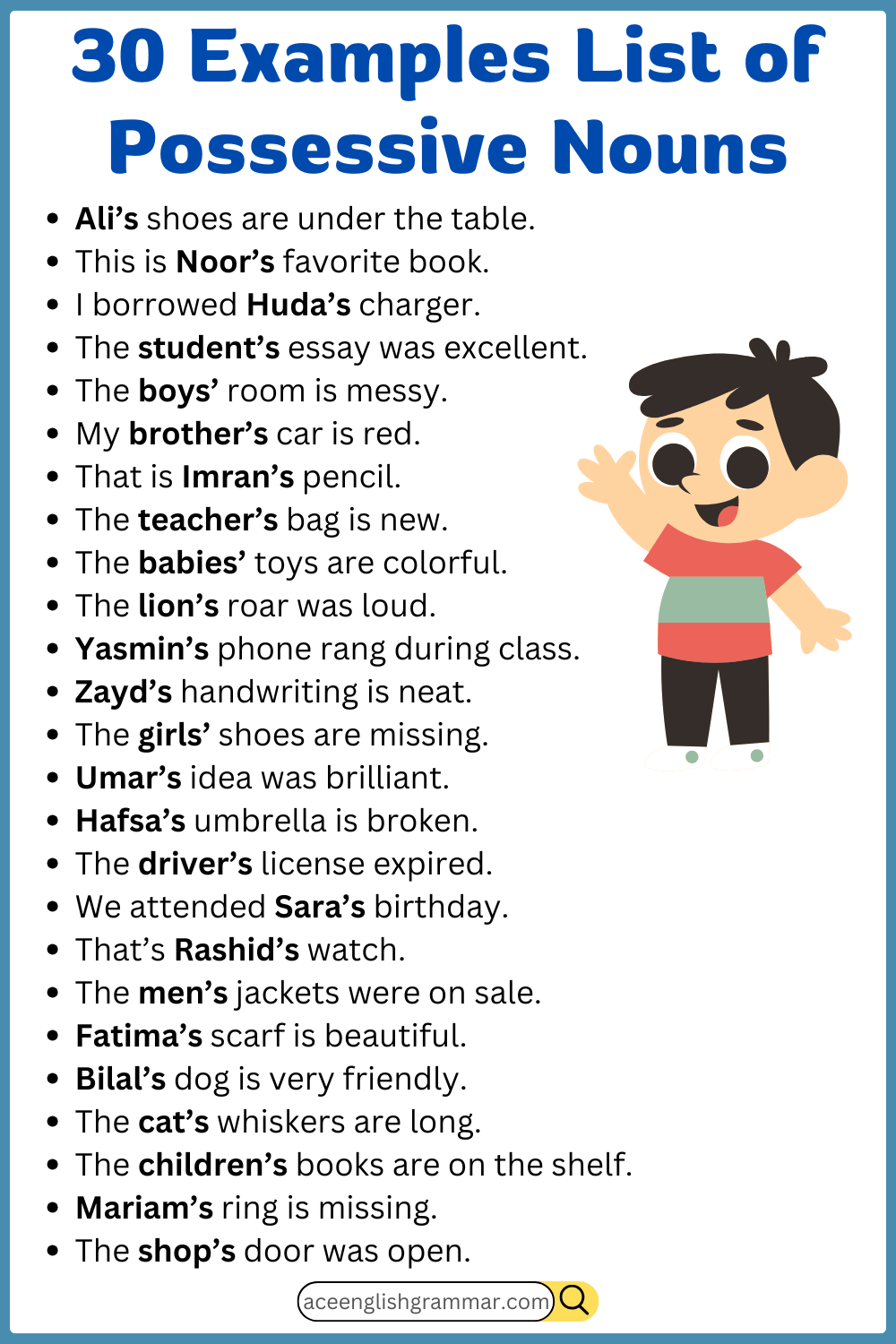
FAQs
A possessive noun shows ownership or belonging. It is formed by adding an apostrophe and sometimes an “s” to a noun.
Add ’s to singular nouns and irregular plurals. For regular plural nouns ending in s, just add an apostrophe (’) at the end.
A possessive noun uses a name or object with ’s (e.g., Ali’s pen), while a possessive pronoun replaces the noun entirely (e.g., his, hers).
No, it should be “the boys’ hats” because boys is already plural and ends in s. Just add the apostrophe.
Yes. For example, “parents’ house” shows something that belongs to more than one parent.
Bilal’s dog is very friendly.
The cat’s whiskers are long.
The children’s books are on the shelf.
Mariam’s ring is missing.
The shop’s door was open.
Conclusion
Understanding possessive nouns is key to showing ownership correctly in English. This post provided a clear possessive nouns list, grammar rules, usage examples, and comparisons with pronouns. With these tools, you can now write and speak with greater accuracy and clarity.
Read More

